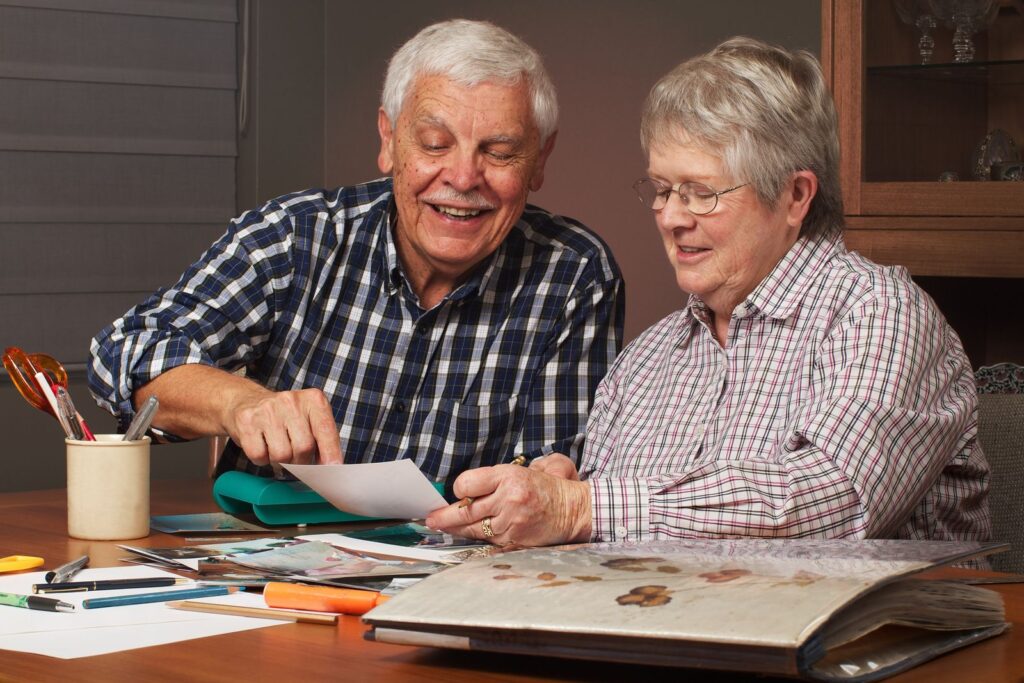
Organize Your Photos & Mementos by Scrapbooking
If you’re like most of us, you’ve probably been collecting photos and mementos for decades. You probably have countless favorite snapshots of people and events from the past, as well as items like ticket stubs, programs, matchbooks, invitations, certificates, etc. Many of these things end up tucked away somewhere and forgotten. Scrapbooking is a great way to get all the important ones out of storage, organize them, and display them in a creative way.
You may think scrapbooking sounds like a daunting task. But, it really isn’t. Scrapbooking can be a fun, easy way to take a walk down memory lane and have something to show for it when you’ve finished. All it takes is time, creativity, and some basic materials that don’t have to cost a lot.
Before you get started, you’ll want to decide whether to go the digital route or make a physical scrapbook by hand. If you have lots of mementos to include and like creating something with your own two hands, you may want to go ahead and do it yourself with actual materials. On the other hand, if you are not a fan of hands-on projects, you might prefer using a scrapbooking computer program or Internet service to make a digital scrapbook.
With a digital scrapbook, you’ll only be able to use photos of the actual items you’ve collected over the years… not the real thing. Digital scrapbooks are usually printed professionally, which makes it possible to make numerous copies for family and friends. With a physical scrapbook, there’s just the original book itself.
If you decide to create your scrapbook by hand, you may want to use a scrapbook kit. They come with just about everything you need to create a beautiful book, including design embellishments. Of course, you still have to supply all the photos, mementos, and memories.
Here’s some information that will help you tackle your first “by hand” scrapbooking project.
“By hand” scrapbooking tips…
- Find a workspace. You’ll want a space where you can store everything and room to spread things out as you work. Make sure it’s a spot where you can be creative without interruption.
- Select your scrapbook. If you decide against using a scrapbooking kit, you’ll find a large selection of individual scrapbooks available. Many people like books with pages that can be rearranged so easy adjustments can be made in page order. The size of your book should depend upon the amount and size of the items you’ll be including. Make sure pages are acid-free to protect your photos and mementos. It’s a good idea to choose a book with page protectors as well. They should be acid-free as well.
- Focus on your intent. It’s helpful to have a game plan before diving into a scrapbooking project. Think about the story you are telling with your book. Come up with a general theme and similar look to tie everything together. Keep some consistency throughout your scrapbook in regard to color and design.
- Plan your colors and layouts in advance. Color will be an important part of the look of your scrapbook. Too many colors can be distracting. Decide on a few colors that go well together and stick to those. Also come up with a few general page layout designs. Sketch out the layouts so you have templates to follow. One layout might be designed around a central photo. Another may include a few photos. Make sure not to clutter or over design your pages. You won’t want to have too much on any single page. Remember, some empty space here and there is welcome and appealing to the eye.
- Gather your content. Find photos and mementos supporting the theme of your scrapbook. Anything small enough to fit in the book is doable. Gather everything together and select the most important items that tell your story best. Group them together by association and chronological order.
- Narrow things down. You may end up with a large number of photos and perhaps even a lot of mementos. Choose the ones that really apply to the theme of your scrapbook and the story you are trying to tell. You’ll also want the photos and mementos to support each other. Fill pages with a mix of photos and mementos. Include documents and flat items as well as pieces with more dimension.
- Collect your tools. Glue, glue sticks, tapes, and other materials should be acid-free and photo safe. Double-sided tape and photo adhesive squares work very well for keeping items in place. If you want to add dimension to any flat items, use foam adhesive squares to lift them up a bit from the page. You’ll need a standard pair of scissors that cut a straight line. Detailing scissors are also fun to use because they add a decorative element. Make sure to use pens with fade resistant ink.
- Find some accent materials. You can add all kinds of design elements to the pages of your scrapbook. You may want to purchase some, like stickers, labels, or ink stamps. Others you may already have around the house, like wrapping paper, buttons, or ribbon. Always use embellishments that go well with your photos, memorabilia, and design.
- Come up with stories and captions. A good scrapbook is about more than photos and mementos. It’s about memories. Words can help tell the stories within a scrapbook. Think of short descriptions, captions, and narratives to add to your pages. Add them with some decorative, creative flair.
- Involve other people. Family and friends can be a great resource when scrapbooking. They may have photos and mementos to add to your collection. They may have some stories and memories to inspire you. Sit down with people and talk about your project. You may want to have some specific questions ready and even record your conversations.
- Look at the big picture. If you’re working with a scrapbook that has removable pages, it helps to take the pages out and spread them all in front of you while you are working. That way, you can lay out one page at a time while being able to see all others. Don’t attach anything permanently until you know you’re happy with all your pages. Once you’re completely satisfied with the entire look, go ahead and adhere items in place. Come up with an order for your pages and place them back in the book.
- Don’t be afraid to get started! The project may seem overwhelming when you first take a good look at all your photos, mementos, materials, and tools. But, once you jump in, the project will probably end up being a whole lot easier and more fun than you imagined. Just take a deep breath and begin.


Age Adds Flavor
We are not old, we are seasoned!
Don’t forget to visit us on FACEBOOK!
